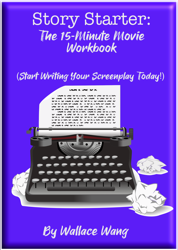If you’ve ever seen a fractal, it’s a geometric pattern that endless repeats itself. This creates beauty, harmony, and art, which is exactly what you want to create when you create a story.
In storytelling, you have your big story (what’s it about?) Then you have individual Acts and within those Acts, you have individual scenes. Yet all scenes and all Acts must focus on telling the exact same story but from different perspectives. This is how you create scenes that subtly support your overall story rather than distract from it.
Watch any bad movie (“Borderlands”, “The 355”, or “Mortal Engines”) and ask yourself if you know what story is trying to tell you. Chances are good you won’t have a clue because the screenwriter didn’t have a clue. Without a strong theme or message, even the best story idea will become directionless.
Now watch a favorite movie (“The Shawshank Redemption”, “Star Wars”, or “The Matrix”) and ask yourself if these stories have a clear, distinct message. Chances are good that they do. Now study any part of a great movie and you’ll notice that great movies constantly reinforce their overall message in different ways.
In “The Shawshank Redemption”, the theme is about hope. So throughout the story, every scene is about someone gaining hope or losing hope. There’s no scene that ignores the idea of hope altogether. We see an elderly prisoner finally get out of prison and find himself hopelessly lost in a world where he doesn’t belong. So he kills himself, which is also a warning of the fate of the hero’s friend if he doesn’t embrace hope as well.
So before you write your story with all the details, ask yourself what’s the strongest message you want your story to say. Then make sure every scene in your story reflects that message. Every scene then bounces back and forth between these two extremes until one extreme finally winds out in the end.
In “Legally Blonde”, the theme is that woman can be strong and independent. Therefore, Elle, the hero, constantly finds herself in scenes that challenge her to either move closer towards becoming a strong, independent woman, or becoming a dependent, weak woman. Every scene should either be positive or(moving the hero towards changing into a better person, or negative, tempting the hero to give up like this:
- (+) Elle is shopping for clothes and a dishonest sales woman tries to take advantage of her, but Elle proves she’s smarter than the sales lady.
- (-) Elle thinks Warner, her boyfriend, will propose to her.
- (+) Elle decides to follow Warner into law school and studies hard enough to submit an application that gets her in.
- (-) Once in law school, Elle tries to win Warner back by hanging around wherever he goes but learns he has a fiance.
- (+) After Warner insults Elle’s intelligence, Elle studies even harder and starts to excel in law school.
- (-) Elle gets picked to help her law professor’s court case, but she’s treated like a second class citizen because she’s a woman.
- (+) Elle uses her bubbly personality and sorority background to get an alibi from the client, which the client wouldn’t give anyone else.
- (-) Elle’s professor tells her he picked her for her looks, making her feel like just another bimbo.
- (+) Elle takes charge of the court case.
- (-) Elle’s inexperience in court shows, threatening to humiliate her.
- (+) Elle finds a fatal flaw in the key witnesses’s story and gets her to confess as the killer, so Elle wins her first court case.
While you can break down “Legally Blonde” in different ways, the main point is that each scene keeps the hero off balance by constantly pulling her in one direction or the other. Will she succumb to being just another eye-candy bimbo lawyer, or will she prove to be a strong, independent woman? That question runs throughout the story and only gets answered in the end.
When writing your story, make sure you’re clear on what question your story is asking. Then you’ll always know how to write a scene that pulls the hero in one direction or the other, creating unity of story and tension as we wait to see which choice the hero will finally make.
Sign up to take a FREE course about how to write scenes in a screenplay.

